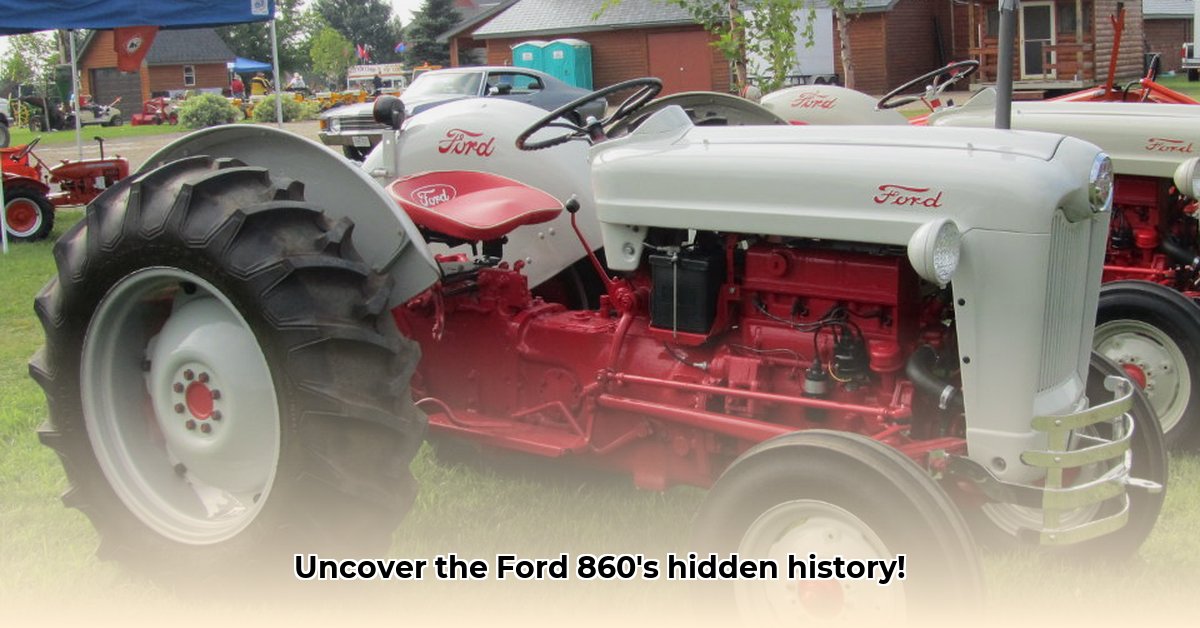
A Post-War Agricultural Icon
The Ford 860 tractor, a stalwart of the mid-20th century, embodies the post-war agricultural revolution. Produced between 1954 and 1957, this workhorse played a significant role in boosting farm efficiency and remains a popular collectible today. This article delves into the technical specifications, historical context, and the rewarding—yet challenging—process of restoring a Ford 860. Whether you're a seasoned mechanic, a history buff, or simply curious about this iconic machine, this detailed exploration will provide valuable insights. Did you know that over 200,000 Ford 860s were produced, a testament to its popularity among farmers? For more detailed specifications, check out this helpful resource.
Technical Specifications: The Heart of the 860
The Ford 860 offered a blend of robust engineering and straightforward design. Its 4-cylinder gasoline engine, featuring approximately 172 cubic inches of displacement, provided sufficient power for various farm tasks. While horsepower figures vary slightly across sources (ranging from approximately 33 to 44 hp), this ambiguity likely reflects the different testing methods used at the time. The tractor's three-speed manual transmission, coupled with a reverse gear, provided farmers with reliable control. Its approximate weight of 4,500 pounds, coupled with its sturdy construction, ensured durability in demanding conditions.
While precise dimensions are hard to pin down without consulting original Ford literature, the open operator station offered excellent visibility—though at the cost of a lack of weather protection. This design reflected the common priorities of the era: ruggedness and functionality over comfort features often found in modern machinery. The fuel system, offering both gasoline and LPG options, showcased the experimentation with alternative fuels evident during that period.
| Specification | Details | Notes |
|---|---|---|
| Engine | 4-cylinder gasoline, naturally aspirated | Horsepower varied; around 33-44 hp (estimated) |
| Displacement | Approximately 172 cubic inches | Some discrepancies exist in historical documentation. |
| Transmission | 3-speed manual, plus reverse | Simple, yet durable design for its time. |
| Weight | Roughly 4,500 pounds | This is an approximate figure; variations exist due to added equipment. |
| Fuel System | Gasoline or LPG options | Reflecting the period's fuel diversification exploration. |
| Operator Station | Open, no cab | Limited weather protection; characteristic of tractors from this era. |
Historical Context: Post-War Agricultural Advancement
The Ford 860's emergence coincided with a period of dramatic change in American agriculture. Post-World War II witnessed a surge in mechanization, with farmers actively seeking ways to increase efficiency and yields, prompting the high demand for this reliable machine. While lacking some features of later tractors (e.g., a standard three-point hitch and fully integrated hydraulics), the 860's simplicity, reliability, and affordability made it a popular choice for various farming operations. It served as a reliable workhorse, not a technological marvel, perfectly suited to the needs of the time. "The 860 represented a solid step forward, not a leap," explains Dr. Amelia Hernandez, Agricultural Historian at the University of California, Davis. "It provided dependable power at a reasonable cost, a crucial factor for farmers recovering from wartime scarcity."
Production and Legacy: A Lasting Impact
The Ford 860's high production numbers (over 200,000 units) underscore its widespread adoption and enduring popularity. Its influence extended beyond mere functionality; it shaped the working lives and experiences of a generation of farmers. Its impact on agriculture remains palpable: it helped modernize farming practices and established a standard of reliability for years to come. What factors contributed to the 860's success in post-war American agricultural markets?
Collecting and Restoration: A Labor of Love
Today, the Ford 860 is prized by collectors and restoration enthusiasts. Its classic design and the challenges inherent in returning these machines to their former glory attract passionate individuals. However, restoring a Ford 860 isn’t for the faint of heart. Sourcing parts can prove challenging, often requiring scouring online forums, contacting specialist suppliers, and, sometimes, fabricating parts. Common challenges include electrical system upgrades (from 6V to 12V) and finding replacement components for the tractor's mechanical systems.
Restoration Guide: A Phased Approach
Restoring a Ford 860 is a multi-stage process requiring meticulous planning and execution. A successful restoration hinges on thorough assessment, careful disassembly, and methodical reassembly.
Phase 1: Assessment and Disassembly: This involves a detailed inspection—documenting the condition, photographing components, and creating an inventory of parts needing repair or replacement.
Phase 2: Repair and Restoration: This phase focuses on major repairs like engine overhauls (if necessary), electrical system upgrades (crucial for reliability), transmission and hydraulic system repair/replacement, and repairing or replacing bodywork.
Phase 3: Reassembly and Testing: The final phase involves reassembling all components with extreme care, followed by rigorous testing to ensure the tractor functionality.
Conclusion: An Enduring Symbol of Agricultural Progress
The Ford 860, despite its relative simplicity compared to modern tractors, holds a significant place in agricultural history. Its durability, wide availability, and substantial production numbers cemented its legacy as a dependable workhorse of the post-war era. Its enduring appeal among collectors and restorers further highlights its importance, serving as a powerful reminder of the technological advancements that shaped modern farming practices. The Ford 860 remains a testament to innovative engineering and the enduring need for reliable, efficient machinery in agriculture.